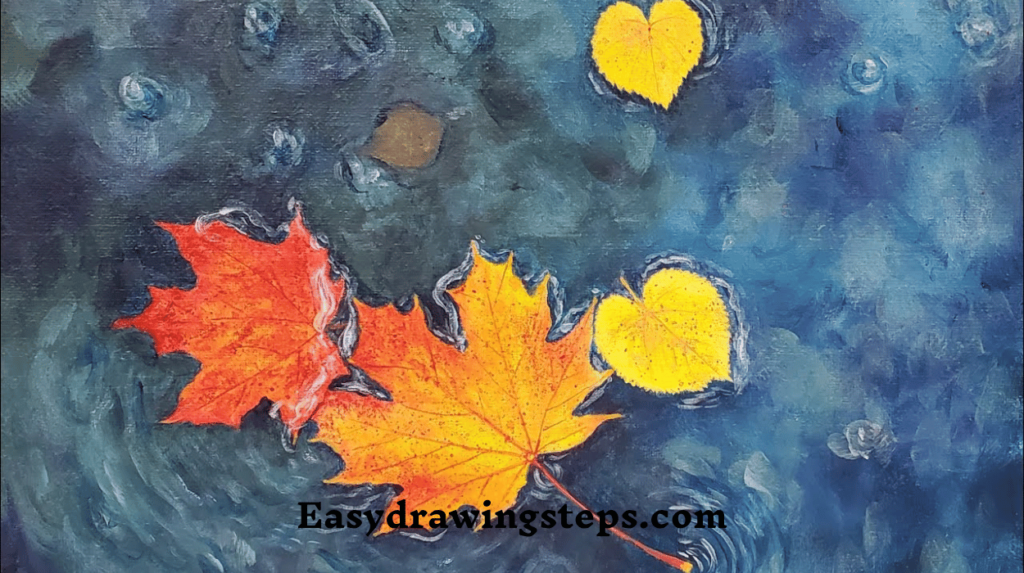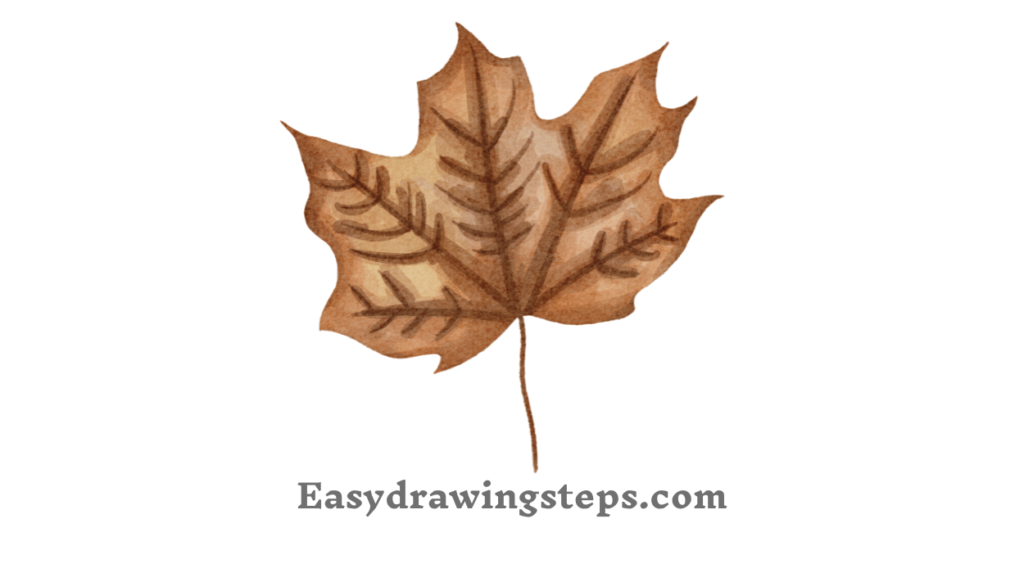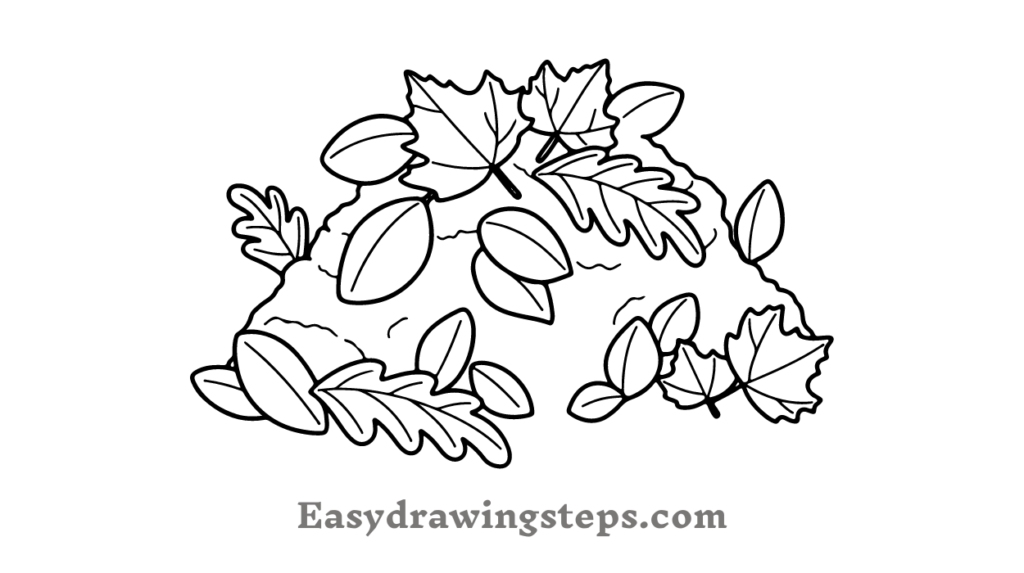Fall Leaves Drawing : Drawing fall leaves is a delightful way to celebrate the autumn season. The vibrant colors and unique shapes of leaves make this subject perfect for artists of all levels.
Whether you are just starting or are looking for a relaxing project, this easy fall leaves drawing guide will help you capture the essence of autumn.
Follow along as we break down how to draw simple, yet beautiful fall leaves in just 10 easy steps.
Step 1: Gather Your Supplies
Before we dive into the drawing, make sure you have the necessary materials:
- Pencil
- Eraser
- Colored pencils or markers (in fall colors like red, orange, yellow, and brown)
- Paper
These basic supplies will help you bring your autumn fall leaves drawing to life.

Step 2: Sketch the Outline of the Leaf
Start by drawing a basic outline of a leaf. Choose a simple shape like a maple or oak leaf to begin with. Use light strokes so you can easily erase any mistakes. The key is to keep it simple, ensuring the leaf shape looks natural. This step is the foundation of your fall leaves drawing.
Also Read : 10 Easy Steps to Draw Trishul Drawing
Step 3: Draw the Leaf Veins
Once you have the outline, it’s time to add some veins to make your leaf more realistic. Draw a central line down the middle of the leaf, then add smaller veins branching out from the center. These veins help give your realistic fall leaves drawing a more authentic feel.
Step 4: Refine the Edges
Now, refine the edges of your leaf. Instead of a smooth line, make the edges jagged or curved to mimic the natural shape of fall leaves. Leaves tend to have irregular edges, especially in the autumn season when they start to dry up and change shape. This will add character to your simple fall leaves drawing.

Step 5: Add Additional Leaves
If you want to create a more detailed fall scene, add a few more leaves around the first one. Try drawing different types of leaves, like an elm or birch leaf, to show a variety of shapes. For an autumn fall leaves drawing, having multiple leaf shapes creates a fuller, more dynamic composition.
Step 6: Add Color
Now comes the fun part—coloring your fall leaves drawing! Use shades of red, yellow, orange, and brown to capture the vibrant colors of fall. Layer your colors to create depth and dimension. For example, start with a base color and add darker shades around the veins for a more realistic effect.
Also Read : 10 Easy Steps to Draw Swachhata Drawing
Step 7: Create Shadows and Highlights
To make your fall leaves look more three-dimensional, add shadows and highlights. Use darker tones along the edges of the leaves and lighter shades near the center. This technique will give your autumn fall leaves drawing a realistic touch, as it mimics the way light falls on real leaves.
Step 8: Add Ground or Background Elements
If you want to take your drawing to the next level, add some background elements like grass, a tree trunk, or a light breeze. This will create a more complete scene and highlight the beauty of fall. A simple fall leaves drawing can turn into an autumn landscape with just a few additional touches.
Also Read : 10 Easy Steps to Draw Vinayaka Drawing
Step 9: Final Touches
Review your drawing and make any necessary adjustments. Clean up any stray lines, sharpen the edges, and ensure the colors are vibrant and well-blended. If you are using markers or colored pencils, this is the perfect time to add final details to make your easy fall leaves drawing pop.
Step 10: Enjoy Your Artwork
Once you’ve completed all the steps, take a moment to admire your work. You’ve successfully created a beautiful fall leaves drawing that captures the essence of autumn. Whether you hang it up, gift it to a friend, or keep it as a personal reminder of the season, your realistic fall leaves drawing will be a piece you can be proud of.
Drawing fall leaves is a rewarding and calming activity that allows you to explore the beauty of nature in autumn. By following these 10 easy steps, you’ll be able to create an autumn fall leaves drawing that is simple yet stunning.
Whether you’re interested in a realistic fall leaves drawing or prefer a more whimsical approach, this guide gives you the foundation to experiment and have fun.
With just a few colors and techniques, your drawing will capture the magic of the season. So grab your supplies and enjoy the process of creating your own easy fall leaves drawing masterpiece!
Fall Leaves Drawing FAQ
What materials do I need to create a fall leaves drawing?
To create a fall leaves drawing, you’ll need a pencil for sketching, an eraser for corrections, and colored pencils, markers, or crayons in autumn colors such as red, orange, yellow, and brown. You’ll also need paper to draw on. Optional materials include blending tools or shading pencils to enhance the realism of your leaves by creating depth and texture.
How do I make my fall leaves drawing look realistic?
To make your fall leaves drawing look realistic, focus on adding detailed elements like leaf veins, shadows, and highlights. Begin by drawing the leaf’s basic outline, then incorporate the intricate veins that extend from the center to the edges. Use shading techniques to give the leaf depth and dimension, and blend varying shades of autumn colors, such as deep reds, oranges, and yellows, to mimic the look of real fall leaves.
Can beginners easily draw fall leaves?
Yes, fall leaves are an excellent subject for beginners because their shapes are simple and easy to replicate. You can start with basic shapes like ovals and jagged edges, and follow a step-by-step approach to create a finished piece. Beginning with an outline, refining the edges, and gradually adding color makes it simple for anyone to create a beautiful fall leaves drawing, regardless of skill level.
What types of leaves are best for an autumn fall leaves drawing?
For an autumn fall leaves drawing, common types of leaves such as maple, oak, elm, and birch work perfectly. Maple leaves are broader and jagged, while oak leaves are more elongated, giving your drawing variety. By incorporating different leaf shapes, you can create a more interesting and visually dynamic composition that captures the diversity of autumn foliage.
What colors should I use in my fall leaves drawing?
To capture the essence of autumn, you should use warm, rich colors like red, orange, yellow, and brown in your fall leaves drawing. Blending these colors together adds depth and makes the leaves appear more vibrant and dynamic. For a more realistic look, experiment with layering different shades of these colors to show the natural variation found in real fall leaves.



5 thoughts on “10 Easy Steps to Draw Fall Leaves Drawing”